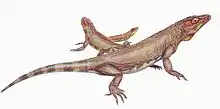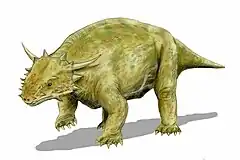Scoloparia
Scoloparia is an extinct genus of procolophonid parareptile from the Triassic of Canada. Fossils have been found in the Early Triassic to Norian-age Wolfville Formation in Nova Scotia, Canada.[2] Like many Triassic procolophonids, Scoloparia has expanded molar-like teeth that indicate that the animal was likely herbivorous.[3]
| Scoloparia Temporal range: Triassic, ? | |
|---|---|
| Scientific classification | |
| Domain: | Eukaryota |
| Kingdom: | Animalia |
| Phylum: | Chordata |
| Class: | Reptilia |
| Clade: | †Parareptilia |
| Order: | †Procolophonomorpha |
| Family: | †Procolophonidae |
| Subfamily: | †Leptopleuroninae |
| Genus: | †Scoloparia Sues and Baird, 1998[1] |
| Type species | |
| †Scoloparia glyphanodon Sues and Baird, 1998[1] | |
References
- Sues, Hans-Dieter; Baird, Donald (1998). "Procolophonidae (Reptilia: Parareptilia) from the Upper Triassic Wolfville Formation of Nova Scotia, Canada". Journal of Vertebrate Paleontology. 18 (3): 525–532. doi:10.1080/02724634.1998.10011079.
- Cisneros, J. C. (2008). "Phylogenetic relationships of procolophonid parareptiles with remarks on their geological record". Journal of Systematic Palaeontology. 6 (3): 345–366. doi:10.1017/S1477201907002350. S2CID 84468714.
- Jenkins, Kelsey M.; Bhullar, Bhart-Anjan S. (2022-04-21). "Tooth Implantation and Attachment in Scoloparia glyphanodon (Parareptilia: Procolophonidae)". Bulletin of the Peabody Museum of Natural History. 63 (1). doi:10.3374/014.063.0103. ISSN 0079-032X.
This article is issued from Wikipedia. The text is licensed under Creative Commons - Attribution - Sharealike. Additional terms may apply for the media files.






